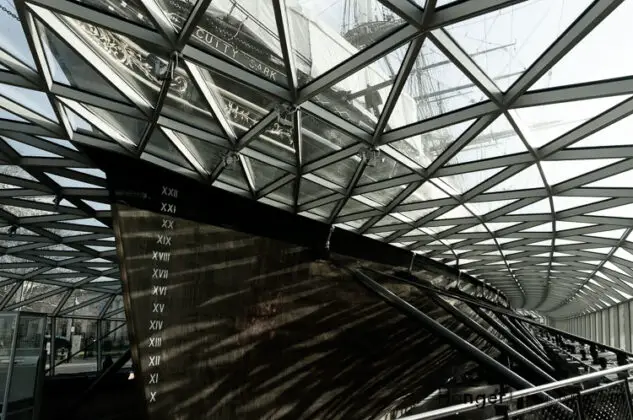The Incredible Restoration of the Cutty Sark
Since 1954 the Cutty Sark had been sitting in a dry dock in Greenwich, bow facing out towards the Isle of Dogs in front of the passage of water the crew of the Cutty Sark had sailed passed on those great voyages to the Far East. Over the years the exposed ship was clearly showing signs of decline and was in need of a new round of restoration.
The ship launched in 1869 with a typical 30 year life expectancy, which should have seen the boat consigned to the history books in the closing years of Queen Victoria’s reign. It is incredible to think that more than a century later the ship survives.
Cutty Sarks conservation objectives in 2006
In 2006 the first round of major conservation project began, at a cost of £25 million project with initial lottery grant of £11.75 million. The ship at this time was 2 years short of loosing its public safety license, making the conservation effort a just in time effort to safe the ship for the nation.
The projects aim was to strip back, restore and repair and at the time controversially raise the 900 tonne ship off 3m of the floor to allow the public to walk under the mighty clipper. To solve this engineering problem, the Ship would be supported by 12 large steel beams that would distribute the weight of the hull.
Cutty Sarks Rock Elm wooden Hull with a Teak Top
The ships hull has a wrought Iron framework with the hard word Cork Elm, or Rock Elm (Ulmus thomasii) planks lining below the water line. Rock Elm is a native Canadian hardwood with its high strength making it the ideal hardwood to be fitted to many sailing ships. The wood also has excellent bending qualities.
Above the water line the ship was planked out with solid teak wood. The 1950s restoration efforts put a plywood decking on the ship, these early restoration efforts have been totally removed to be replaced by solid teak wood, salvaged from an old building in India. . In its day this was the sports car of elegant and technical Victorian engineering.
Cutty Sark’s secret design weapon: Muntz metal.
One of the key restoration areas to be fixed and brought back to its full glory was the hulls unique metal cladding, which was part of the ships secret advantage. The hull is quite literally sheaved in a Muntz metal cladding that serves the purpose of reducing the growth of barnacles and weeds, with the outcome of reducing drag. The cost of the metal was therefore offset by the speed advantageous and reduced maintenance requirements of needing to clean the hull.
Muntz metal, abbreviated as Y.M in the Lloyds Register as it is also known as yellow metal, is a brass alloy consisting of 60 percent copper and 40 percent zinc. The metal was patented by Englishman George F Muntz 40 years before the ship was built in 1832. Not a new metal at the time, but a new application for the metal in the form of using to line the hull of a ship. Muntz metal must be worked hot, which adding technical challenges, and cost to the ship builder at the time, to working the metal on such a large space. You can begin to see how the original ship builder was put out of business by under pricing a project that was far from a typical ship build.
Is Muntz metal expensive?
Muntz metal is cheaper than pure copper, around 2/3rds the cost, sharing many of the same qualities making it a great choice of metal on budget grounds. Back in 1869 when the ship was being laid down it was an evolution of design thinking to line a ships hull with this metal, but would go on to become more common with ship building.
Salvaging Yellow Metal
Those in the ship wreck salvage trade may refer to the discovery and recovery of yellow metal on old ship wrecks. To the casual reader you may think this is a reference to Gold. It is simply the reference to Muntz Metal which is also known as Yellow metal.

HRH the Duke of Edinburgh and the Cutty Sark
1954 HRH Duke of Edinburgh laid the foundation stone at Greenwich. He was the patron of the Cutty Sark Preservation Society that established in 1953. Its aim was to bring the sailing ship to Greenwich as an attraction to visitors, a memorial to the merchant navy and a sailing ship era. Cutty Sark Made its last journey from East India Dock where it was being restored to Greenwich its resting place on 10 Dec 1954. The Duke became Baron of Greenwich and his previous career in the Navy always led him to a connection with ships.
25th June 1957 The Queen and Duke of Edinburgh opened the Ship to the Public.
The Great fire of the Cutty Sark
Yes, in 2007 but much of the original structure survived. Also, smaller fire in Oct of 2014. The fire of 2007 went around thee world with head lines leading to the cause of fire being arson. Fire investigations would go on to dismiss the source of fire from arson to a restoration accident.



